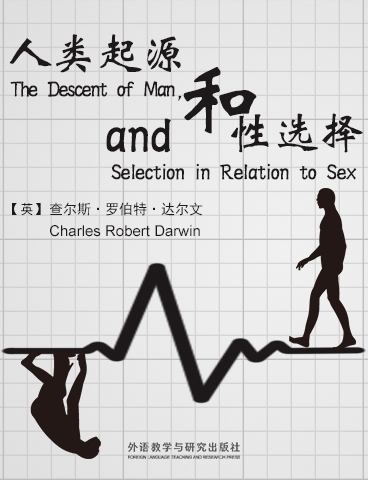The Descent of Man and Selection in Relation to Sex is Darwin's second most important work. In the current resurgence of interest in the biological basis of animal behavior and social organization, the ideas and questions pursued by Charles Darwin remain fresh and insightful.
《人类起源和性选择》出版于1871年。该书报告了人类自较低的生命形式进化而来的证据,报告了动物和人类心理过程相似性的证据,还报告了进化过程中自然选择的证据。达尔文提出“人猿同祖”,并认为人与动物具有心理上的连续性。是达尔文继《物种起源》后,将进化论用于人类学的研究,并解开了人类起源之秘的经典著作。
The Descent of Man, and Selection in Relation to Sex is a book on evolutionary theory by English naturalist Charles Darwin, first published in 1871. It was Darwin's second book on evolutionary theory, following his 1859 work, On the Origin of Species, in which he explored the concept of natural selection. In The Descent of Man, Darwin applies evolutionary theory to human evolution, and details his theory of sexual selection, a form of biological adaptation distinct from, yet interconnected with, natural selection. The book discusses many related issues, including evolutionary psychology, evolutionary ethics, differences between human races, differences between sexes, the dominant role of women in choosing mating partners, and the relevance of the evolutionary theory to society.
- INTRODUCTION.
- CHAPTER I. THE EVIDENCE OF THE DESCENT OF MAN FROM SOME LOWER FORM. (Part I. Descent or Origin of Man)
- CHAPTER II. ON THE MANNER OF DEVELOPMENT OF MAN FROM SOME LOWER FORM. (Part I. Descent or Origin of Man)
- CHAPTER III. COMPARISON OF THE MENTAL POWERS OF MAN AND THE LOWER ANIMALS. (Part I. Descent or Origin of Man)
- CHAPTER IV. COMPARISON OF THE MENTAL POWERS OF MAN AND THE LOWER ANIMALS (Continued). (Part I. Descent or Origin of Man)
- CHAPTER V. ON THE DEVELOPMENT OF THE INTELLECTUAL AND MORAL FACULTIES. DURING PRIMEVAL AND CIVILISED TIMES. (Part I. Descent or Origin of Man)
- CHAPTER VI. ON THE AFFINITIES AND GENEALOGY OF MAN. (Part I. Descent or Origin of Man)
- CHAPTER VII. ON THE RACES OF MAN. (Part I. Descent or Origin of Man)
- CHAPTER VIII. PRINCIPLES OF SEXUAL SELECTION. (Part II. Sexual Selection)
- CHAPTER IX. SECONDARY SEXUAL CHARACTERS IN THE LOWER CLASSES OF THE ANIMAL KINGDOM. (Part II. Sexual Selection)
- CHAPTER X. SECONDARY SEXUAL CHARACTERS OF INSECTS. (Part II. Sexual Selection)
- CHAPTER XI. INSECTS, Continued'ORDER LEPIDOPTERA. BUTTERFLIES AND MOTHS. (Part II. Sexual Selection)
- CHAPTER XII. SECONDARY SEXUAL CHARACTERS OF FISHES, AMPHIBIANS, AND REPTILES. (Part II. Sexual Selection)
- CHAPTER XIII. SECONDARY SEXUAL CHARACTERS OF BIRDS. (Part II. Sexual Selection)
- CHAPTER XIV. BIRDS'Continued. (Part II. Sexual Selection)
- CHAPTER XV. BIRDS'Continued. (Part II. Sexual Selection)
- CHAPTER XVI. BIRDS-Concluded. (Part II. Sexual Selection)
- CHAPTER XVII. SECONDARY SEXUAL CHARACTERS OF MAMMALS. (Part II. Sexual Selection)
- CHAPTER XVIII. SECONDARY SEXUAL CHARACTERS OF MAMMALS'Continued. (Part II. Sexual Selection)
- CHAPTER XIX. SECONDARY SEXUAL CHARACTERS OF MAN. (Part III. Sexual Selection in Relation to Man and Conclusion)
- CHAPTER XX. SECONDARY SEXUAL CHARACTERS OF MAN'Continued. (Part III. Sexual Selection in Relation to Man and Conclusion)
- CHAPTER XXI. GENERAL SUMMARY AND CONCLUSION. (Part III. Sexual Selection in Relation to Man and Conclusion)
- 书评 写书评
- 笔记
-
书评加载中...






















 京公网安备 11010802032529号
京公网安备 11010802032529号
笔记加载中...